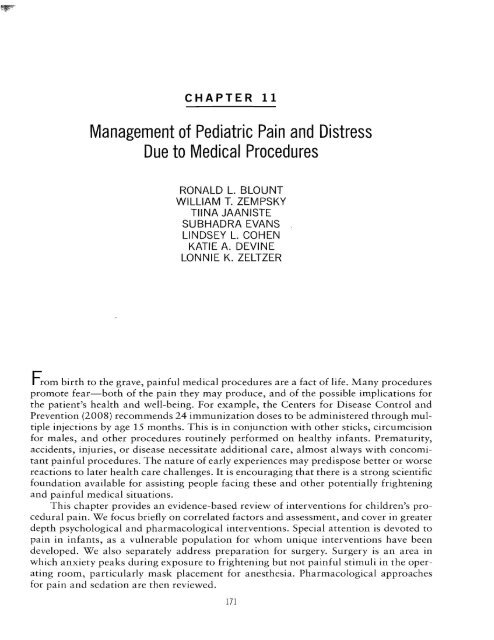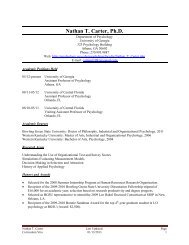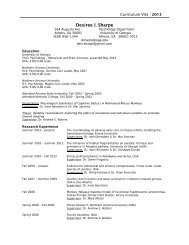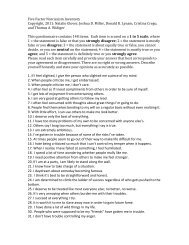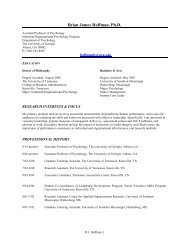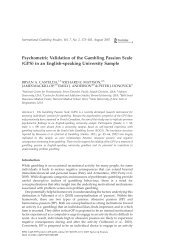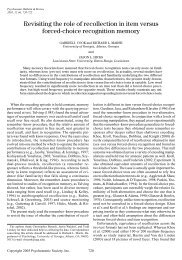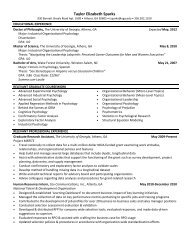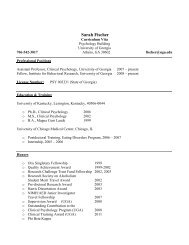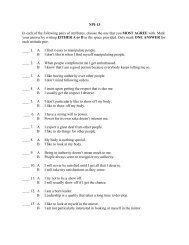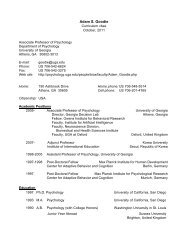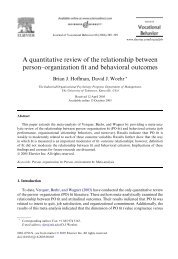Management of Pediatric Pain and Distress Due to Medical ...
Management of Pediatric Pain and Distress Due to Medical ...
Management of Pediatric Pain and Distress Due to Medical ...
You also want an ePaper? Increase the reach of your titles
YUMPU automatically turns print PDFs into web optimized ePapers that Google loves.
174 II. CROSS-CUTTING ISSUEScoping behaviors, are associated with higher child distress <strong>and</strong> indicate targets for intervention.Furthermore, there are effective coping skills training interventions <strong>to</strong> enhanceadults' use <strong>of</strong> coping-promoting behaviors (e.g., Blount et aI., 1994). For this reason,we strongly advocate teaching adults <strong>to</strong> use coping-promoting behaviors. If they do so,distress-promoting behaviors will naturally decrease. Training only parents or nurses <strong>to</strong>use coping-promoting prompts may be adequate for some children <strong>to</strong> increase their coping<strong>and</strong> lower their distress. If not, a child training component can be added.AssessnlentMethods for assessing procedural pain <strong>and</strong> distress include children's self-reports,reports by others, observational measures, <strong>and</strong> (less frequently) physiological moni<strong>to</strong>ring.We do not believe that there is a "gold st<strong>and</strong>ard," with one assessment methodclearly superior <strong>to</strong> others. Each approach has unique strengths <strong>and</strong> weaknesses. Ratherthan recommending particular instruments, we refer the reader <strong>to</strong> scholarly reviews bythe Society <strong>of</strong> <strong>Pediatric</strong> Psychology's Evidence-Based Assessment (SPP-EBA) Task Forceon <strong>Pain</strong> Assessment (Cohen et aI., 2008) <strong>and</strong> by the <strong>Pediatric</strong> Initiative on Methods,Measurement, <strong>and</strong> <strong>Pain</strong> Assessment in Clinical Trials (Stinson, Kavanagh, Yamada,Gill, & Stevens, 2006; von Baeyer & Spagrud, 2007). There are both overlaps <strong>and</strong> differencesin these two groups' findings. Some overlaps <strong>and</strong> differences in the reviews <strong>of</strong>observational measures are discussed by Blount <strong>and</strong> Loiselle (2009).In addition <strong>to</strong> assessing pain <strong>and</strong> distress, we recommend measuring children's copingbehaviors <strong>and</strong> adults' behaviors during the procedures. These malleable child <strong>and</strong>adult behaviors help determine the amount <strong>of</strong> pain <strong>and</strong> distress children will experience.A recent review <strong>of</strong> coping inven<strong>to</strong>ries by the SPP-EBA Task Force's Workgroup on Coping<strong>and</strong> Stress should aid in instrument selection (Blount, Simons, et aI., 2008).Preparing Children for <strong>Pain</strong>ful Procedures: Information 'ProvisionChildren who are better informed generally have lower distress <strong>and</strong> are better adjustedduring <strong>and</strong> after the procedure. Timely, age-appropriate information may provide adegree <strong>of</strong> exposure that reduces anxiety <strong>to</strong> potentially frightening medical situations,as well as help the child <strong>and</strong> parents correctly anticipate what the procedure entails.Also, coping skills training may be conducted in conjunction with information provision(Jaaniste, Hayes, & von Baeyer, 2007b).The type <strong>of</strong> preparation program is important. O'Byrne, Peterson, <strong>and</strong> Saldana(1997) surveyed hospital pr<strong>of</strong>essionals, who rated coping skills, relaxation, <strong>and</strong> filn1. asthe n1.ost effective preparation procedures, <strong>and</strong> <strong>to</strong>urs, printed materials, <strong>and</strong> narrativepreparation as least effective. Of note, the least effective preparation procedures wereendorsed as most frequently used, probably due <strong>to</strong> their ease <strong>of</strong> administration <strong>and</strong> lowcost.Regardless <strong>of</strong> the method used, prepara<strong>to</strong>ry information should be specific ratherthan general, <strong>and</strong> should include procedural (what will be done) <strong>and</strong> sensory (what thepatient will experience or feel) information. The optimal tin1.ing <strong>of</strong> preparation maydepend on the child's age <strong>and</strong> the nature <strong>of</strong> the procedure. Children need earlier <strong>and</strong>
176 II. CROSS-CUTTING ISSUESment for cooperation (Elliott & Olson, 1983), training parents <strong>to</strong> coach their children<strong>to</strong> use coping behaviors (Blount et aI., 1994), <strong>and</strong> having nurses prompt children <strong>to</strong>watch car<strong>to</strong>on videos (Cohen et aI., 1997). These CBT procedures led <strong>to</strong> increased use<strong>of</strong> coping skills, parents' <strong>and</strong> medical staff members' coaching the children, <strong>and</strong> reducedpain <strong>and</strong> distress. Some investigations that included comparisons with pharmacologicalagents found CBT <strong>to</strong> be as effective as, or more effective than, such agents as diazepam(Valium) (Jay et aI., 1987) or EMLA cream (discussed later) (Cohen et aI., 1999). Also,the combination <strong>of</strong> CBT with midazolam (Versed) was better than midazolam alone onsome outcome variables (Kazak et aI., 1996). Powers (1999) concluded that CBT metcriteria <strong>to</strong> be considered as a "well-established treatment" for procedural pain in children<strong>and</strong> adolescents.The beneficial effects <strong>of</strong> distraction have also been supported in a meta-analysis(Kleiber & Harper, 1999). Furthermore, in a Cochrane Database review, Uman, Chambers,McGrath, <strong>and</strong> Kisely (2006) studied psychosocial interventions for 2- <strong>to</strong> 19-yearoldsundergoing needle procedures. The largest effect sizes for treatment versus controlconditions existed for distraction <strong>and</strong> multicomponent CBT interventions, with hypnosisbeing promising. Promising evidence was also found for other interventions, includinginformation/preparation procedures <strong>and</strong> nurse coaching <strong>to</strong> promote child distraction.It is encouraging that the data converge <strong>to</strong> support the effectiveness <strong>of</strong> distractionin particular, as well as multicomponent CBT interventions.Virtual reality (VR) is a novel technique for promoting distraction. VR equipmenttypically consists <strong>of</strong> a head-mounted visual display with audi<strong>to</strong>ry input. In a review,Lange, Williams, <strong>and</strong> Ful<strong>to</strong>n (2006) concluded that the evidence for the use <strong>of</strong> VR wasstrongest for burns. As an intervention for the pain caused by treating burn injuries,H<strong>of</strong>fman, Doc<strong>to</strong>r, Patterson, Carrougher, <strong>and</strong> Furness (2000) designed Snow World, inwhich a patient moves through an ice world with a video-game-like atmosphere. <strong>Pain</strong>was reduced in several studies (see www.hitl.washing<strong>to</strong>n.edu/projects/vrpain; H<strong>of</strong>fmanet aI., 2000). Some limitations <strong>of</strong> VR include the cost <strong>and</strong> technical expertise required;the necessity <strong>of</strong> proper head orientation, which makes it difficult for patients in pronepositions <strong>to</strong> use; <strong>and</strong> possible impaired communication with the patient.Effective Use <strong>of</strong> Distraction ProceduresRegardless <strong>of</strong> the techniques for promoting distraction, the stimuli or activity should behighly engaging, should be easily performed, <strong>and</strong> should require an observable response.Observable responses confirm that the coping behavior is being performed. In addition,prompts by adults can help facilitate children's coping <strong>and</strong> redirect their attention asneeded away from compelling painful or frightening medical procedures. There is someevidence that coping/distracting activities should be matched <strong>to</strong> the dem<strong>and</strong>s <strong>of</strong> differentmedical phases (Blount et aI., 1990). For example, in one study, distracting conversationsor <strong>to</strong>y play helped <strong>to</strong> lower anticipa<strong>to</strong>ry distress, but these techniques werereplaced with prompted use <strong>of</strong> a party blower during painful LPs (Blount et aI., 1994).Using a party blower is simple, is distracting, <strong>and</strong> requires less thought by the childthan nonprocedural talk during painful LPs would require. During painful procedures,simple distraction techniques that do not exceed a patient's limited attentional capacityat that time are probably more effective.
11. <strong>Management</strong> <strong>of</strong> <strong>Pediatric</strong> <strong>Pain</strong>/<strong>Distress</strong>177HypnosisHypnosis involves a state <strong>of</strong> increased suggestibility, attention, <strong>and</strong> relaxation. Althoughthe exact mechanism <strong>of</strong> its action is not well unders<strong>to</strong>od, neuroimaging techniquesshow that hypnosis is associated with activation <strong>of</strong> brain areas consistent with decreasedarousal, visual imagery, <strong>and</strong> possible reinterpretation <strong>of</strong> perceptual experiences (Wood& Bioy, 2008). Hypnosis has been used with children experiencing BMAs (Liossi &Hatira, 2003), fracture pain (Iserson, 1999), <strong>and</strong> pos<strong>to</strong>perative pain <strong>and</strong> anxiety (Lambert,1996). Uman <strong>and</strong> colleagues (2006) found hypnosis <strong>to</strong> be a promising interventionfor self-reported pain in children <strong>and</strong> adolescents. However, hypnosis may be lesseffective for children under 5 years <strong>of</strong> age, <strong>and</strong> some people are not easily hypnotized(Liossi, White, & Hatira, 2006). Challenges in the area include the lack <strong>of</strong> agreemen<strong>to</strong>ver operational definitions <strong>of</strong> hypnosis, as well as the heterogeneity <strong>of</strong> techniques thathave been used (hypnotherapy, guided imagery, imagery). Future r~search should establishst<strong>and</strong>ardized treatment manuals <strong>and</strong> should attempt <strong>to</strong> underst<strong>and</strong> efficacy as afunction <strong>of</strong> child age <strong>and</strong> pain type.Combining Information Provision <strong>and</strong> Attention ManipulationA revised version <strong>of</strong> our prescriptive model <strong>of</strong> medical <strong>and</strong> coping interventions by phase<strong>of</strong> medical procedure (Blount et aI., 2003) is presented in Table 11.1. Information provisionincluding both sensory <strong>and</strong> procedural components should be presented <strong>to</strong> bothchild <strong>and</strong> parent during Phase 1, the time prior <strong>to</strong> the procedure. Most studies indicatethat preparation should occur about a week <strong>to</strong> several days before the procedure, atleast for older children (Jaaniste et aI., 2007b; Kain et aI., 1996). This duration mayallow a child <strong>to</strong> mentally prepare for the event or give time for anxiety <strong>to</strong> diminish viaprolonged exposure <strong>to</strong> the information. Preparation is also a time for training parents incoping promoting skills <strong>and</strong> training children <strong>to</strong> use coping behaviors before <strong>and</strong> duringmedical treatments. Home practice can also be incorporated.During Phase 2, the child <strong>and</strong> parent are in the medical setting anticipating the procedure.Rather than introducing new information or dwelling on the upcoming event,playful nonprocedural activities <strong>and</strong> conversation should be used. These activities help<strong>to</strong> lower the child's fear <strong>and</strong> anxiety before the procedure, <strong>and</strong> therefore predisposehim or her <strong>to</strong> lower distress during the next phase (Blount et aI., 1990). As the procedurebecomes imminent <strong>and</strong> preprocedural instructions are given (e.g., "Climb on thetable"), parents <strong>and</strong> staff should continue <strong>to</strong> provide distracting prompts, albeit allowingfor necessary procedural comments (e.g., "a little stick").Phase 3 includes encounter with the painful procedure. Active coaching shouldcontinue. For less painful procedures, distraction techniques such as a continuation <strong>of</strong>Phase 2's use <strong>of</strong> interactive car<strong>to</strong>on viewing (Cohen et aI., 1999) may suffice. For morepainful procedures, such as LPs, prompted use <strong>of</strong> simple coping behaviors that requirelittle cognitive processing (e.g., deep breathing or use <strong>of</strong> distracting party blowers) maybe preferable. If so, practice during the preparation phase may be necessary <strong>to</strong> facilitatea child's performance <strong>of</strong> the desired behaviors. Alternatively, if a trained therapist isavailable, hypnosis may be used (Uman et aI., 2006).
TABLE 11.1. Prescriptive Model <strong>of</strong> <strong>Medical</strong> <strong>and</strong> Coping Interventions by Phase <strong>of</strong> <strong>Medical</strong> ProcedurePhase1Phase 2Phase 3Phase 4Phase 5Temporalproximity <strong>to</strong>procedureApproach <strong>of</strong> the procedureAnticipa<strong>to</strong>ry phase (in thesetting prior <strong>to</strong> medicalprocedure)Procedure (during theprocedure)Postprocedure(immediately after theprocedure)Completion (minutes <strong>to</strong>hours or more after theprocedure)Child experiencesPreparation for upcomingeventAnticipation <strong>of</strong> imminenteventEncounter with thestimulus <strong>and</strong> stressRecovery from pain <strong>and</strong>distressRecollection <strong>and</strong>return <strong>to</strong> normal dailyactivitiesProportion <strong>of</strong>informationprovision <strong>to</strong>distraction• Offer age-appropriatesensory <strong>and</strong> proceduralinformation <strong>to</strong> child <strong>and</strong>parents about the upcomingprocedure.• Provide opportunities <strong>to</strong> askquestions.• Simple, less painfulprocedures require lesspreparation.• Decrease both informationprovision <strong>and</strong> the child'sfocus on the upcomingprocedure.• Increase distraction.• Provide primarilydistraction <strong>and</strong>minimal informationas needed.• Distraction is greatest<strong>and</strong> informationprovision lowest inthis phase.• Continue mild forms<strong>of</strong> distraction.• Begin resumption <strong>of</strong>normal activities asappropriate.• Continue resumption<strong>of</strong> normal lifeactivities...........-......J00 Copinginterventions• Train child <strong>and</strong> adults inspecific coping <strong>and</strong> copingpromotingbehaviors, aswell as when <strong>to</strong> use them.• Anxiety reduction occursvia exposure <strong>to</strong> aspects<strong>of</strong> the stressor, perhapsthrough coping skillspractice.• These fac<strong>to</strong>rs increasechild's <strong>and</strong> parents' sense <strong>of</strong>mastery.• Have parents/staff promptchild's use <strong>of</strong> copingstrategies.• Coping behaviorsmay include movies,nonprocedural talk, <strong>to</strong>yplay, <strong>and</strong> other engagingactivities.• Use problem-focused, notemotion-focused, coping.• Supportive, skilled parents<strong>and</strong> staff instill confidence.• Coach/promptchild <strong>to</strong> use copingbehaviors. Copingbehaviors duringpainful procedures are<strong>of</strong>ten simple, such asbreathing or using aparty blower.• Minimize avoidance.• Lower distress/painshould lead <strong>to</strong> lessclassical conditioning.• Distracting activityor talk can speedreductions in distress,but allow child <strong>to</strong>recover if needed. Besensitive <strong>to</strong> child's lead<strong>and</strong> receptiveness <strong>to</strong>efforts.• Focus on successfulcoping <strong>and</strong> instillsense <strong>of</strong> achievement.• Focus child's attentionon positive copingefforts <strong>to</strong> promptmemory encoding <strong>of</strong>successful coping <strong>and</strong>nonexaggeration <strong>of</strong>distress.• If pain persists,continue engagingactivities (e.g., movie,talk) as needed if childis receptive.<strong>Medical</strong> fac<strong>to</strong>rs<strong>to</strong> consider <strong>and</strong>interventions <strong>to</strong>lise• Assess the child's his<strong>to</strong>rywith procedures, physicalcondition, painfulness,<strong>and</strong> other aspects <strong>of</strong> themedical procedure. Childmay be shown <strong>and</strong> allowed<strong>to</strong> h<strong>and</strong>le simple versions <strong>of</strong>equipment, such as placingmask for anesthesia.• Use <strong>to</strong>pical or otheranesthetics <strong>and</strong>, ifnecessary, sedation <strong>and</strong>analgesics.• Use less threateningor painful medicalinstruments, such as smallgaugeneedles.• Maintain child-friendly• Use less painfulmedical equipment(e.g., smaller needles)<strong>and</strong> <strong>to</strong>pical anesthesia.• Keep unexpectedevents <strong>to</strong> a minimum.• Use pain-reducingmedications as needed.• Use pain-reducingmedications if needed.
11. <strong>Management</strong> <strong>of</strong> <strong>Pediatric</strong> <strong>Pain</strong>/<strong>Distress</strong>179<strong>Distress</strong> diminishes during Phase 4, <strong>and</strong> less intense attentional redirection activitiescan be used <strong>to</strong> help speed the child's recovery. It is important <strong>to</strong> be sensitive <strong>to</strong> thechild's state, as children may be less responsive after highly painful <strong>and</strong> distressingevents. Attempting <strong>to</strong> engage children when they are not likely <strong>to</strong> be responsive canincrease frustration <strong>and</strong> distress.During Phase 5, when the procedure is over <strong>and</strong> the child has recovered, adultsshould praise the child for his or her coping attempts <strong>and</strong> en1.phasize the good things thechild did. This may help the child remember the event as less distressing <strong>and</strong> the copingefforts as more beneficial. Chen, Zeltzer, Craske, <strong>and</strong> Katz (1999) have used a prompted<strong>and</strong> selective memory-encoding procedure similar <strong>to</strong> this <strong>to</strong> help children who mustundergo repeated painful procedures.Preparation for SurgeryChildren's perioperative anxiety is predictive <strong>of</strong> adverse postsurgical outcomes, includingmore pain, increased emergence delirium, <strong>and</strong> negative pos<strong>to</strong>perative behaviors(Kain et aI., 2007). Methods for reducing perioperative anxiety include (1) sedativeadministration before surgery, (2) parental presence, (3) preparation <strong>and</strong> coping skills,<strong>and</strong> (4) hypnosis (Kain et aI., 2007; Wright, Stewart, Finley, & Buffett-]errott, 2007).Midazolam is a commonly used sedative administered prior <strong>to</strong> surgery. Doses in therange <strong>of</strong> 0.25 <strong>to</strong> 0.50 mg/kg are effective for reducing anxiety within 20-30 minutes(Wright et aI., 2007). However, in some patients midazolam has resulted in longer time<strong>to</strong> discharge, longer recovery times, <strong>and</strong> some maladaptive postsurgical behaviors, suchas nightmares (Wright et aI., 2007).Parental presence during mask anesthesia induction has also been investigated.Although most children prefer a parent <strong>to</strong> be with them, well-controlled r<strong>and</strong>omizedtrials have not found evidence supporting the benefit <strong>of</strong> parental presence for reducingchildren's presurgical anxiety (Piira, Sugiura, Champion, Donnelly, & Cole, 2005;Wright et aI., 2007). Instead, it is probable that what parents do is more critical thantheir mere presence (Caldwell-Andrews, Blount, Mayes, & Kain, 2005; Piira et aI.,2005). Investigations are currently underway <strong>to</strong> assess the impact <strong>of</strong> adults' behaviorson children's coping <strong>and</strong> distress during anesthesia induction.Preparation programs for surgery have included information provision, modeling<strong>to</strong> convey what <strong>to</strong> expect <strong>and</strong> how <strong>to</strong> cope, <strong>and</strong> training <strong>of</strong> the child <strong>and</strong> others in copingprocedures (Blount, McCormick, MacLaren, & Kain, 2008; ]aaniste et aI., 2007a).Kain <strong>and</strong> colleagues (2007) used a r<strong>and</strong>omized clinical trial <strong>to</strong> evaluate the effectiveness<strong>of</strong> st<strong>and</strong>ard care, parental presence, oral midazolam at 0.50 mg/kg, <strong>and</strong> the multicomponentADVANCE program. ADVANCE includes techniques for Q.nxiety reduction,distraction, yideo modeling <strong>and</strong> education, Qvoiding excessive reassurance, incorporatingparents, parent ~oaching <strong>of</strong> the child in the holding area through induction, <strong>and</strong> aparent-directed home-based ~xposure/shapingcomponent <strong>to</strong> promote mask familiarity<strong>and</strong> acceptance. Children in the ADVANCE group exhibited lower anxiety in the holdingarea; similar anxiety <strong>to</strong> that <strong>of</strong> children in the midazolam condition, <strong>and</strong> loweranxiety than that <strong>of</strong> the other two groups during mask induction; <strong>and</strong> less emergencedelirium, less need for fentanyl for pain relief, <strong>and</strong> quicker discharge than children in theother three groups following surgery.
11. <strong>Management</strong> <strong>of</strong> <strong>Pediatric</strong> <strong>Pain</strong>/<strong>Distress</strong>181Simons, <strong>and</strong> Hayutin (2008) used the Infant Version <strong>of</strong> the CAMPIS (CAMPIS-IV) <strong>to</strong>conduct a sequential analytic investigation <strong>of</strong> parent, nurse, <strong>and</strong> infant behaviors thatinfluenced 2- <strong>to</strong> 20-month-olds' level <strong>of</strong> crying following immunizations. Strong supportwas found for the benefits <strong>of</strong> sucking a bottle or pacifier, holding an infant in a belly-<strong>to</strong>bellyposition, nonprocedural talk <strong>to</strong> the infant, <strong>and</strong> having the infant play with objects.Some support was found for bouncing, rocking, <strong>and</strong> patting the baby. No support wasfound for adults' reassurance, apologies, or empathic statements <strong>to</strong> an infant; there waseven some indication that reassurance might be detrimental. Behavioral observationstudies using such instruments as the CAMPIS-IV <strong>and</strong> the MAISD may inform thedevelopment <strong>of</strong> new interventions or refine existing ones.Pharmacological <strong>Management</strong> <strong>of</strong> Procedural <strong>Pain</strong> <strong>and</strong> <strong>Distress</strong>When choosing pharmacological interventions for procedural pain <strong>and</strong> anxiety, thepatient's age as well as the invasiveness, painfulness, <strong>and</strong> duration <strong>of</strong> the proceduremust be considered. Some procedures, such as venous access, routinely require local or<strong>to</strong>pical anesthetics; others, whether painful (e.g., LP) or nonpainful (e.g., magnetic resonanceimaging, or MRI), may require potent sedatives <strong>and</strong> analgesics. It is importantfor psychologists <strong>and</strong> other nonmedical pr<strong>of</strong>essionals working in the area <strong>of</strong> acute painmanagement <strong>to</strong> have a basic familiarity with pharmacological approaches.Topical <strong>and</strong> Local AnestheticsTopical <strong>and</strong> local anesthetics are the drugs <strong>of</strong> choice for siniple procedures such asvenipuncture, venous access, laceration repair, subcutaneous port access, <strong>and</strong> derma<strong>to</strong>logicalprocedures (Zempsky, 2006). Among these agents, lidocaine injected subcutaneouslyis effective for decreasing pain from venous access, derma<strong>to</strong>logical procedures,<strong>and</strong> laceration repair. Lidocaine can be injected with little pain if the technique includesbuffering with bicarbonate, warming it before injecting, <strong>and</strong> injecting slowly with asmall-gauge needle.Topical anesthetics allow for needleless dermal anesthesia. However, each <strong>to</strong>picalagent has some shortcoming, such as the time required <strong>to</strong> work or lack <strong>of</strong> adaptability<strong>to</strong> different procedures (Zempsky, 2006). The most extensively studied <strong>of</strong> these agents,Eutectic Mixture <strong>of</strong> Local Anesthetics (EMLA) cream, has been shown <strong>to</strong> be effectivefor a variety <strong>of</strong> procedures, including venous cannulation, venipuncture, immunization,subcutaneous port access, <strong>and</strong> LPs (Uhari, 1993). EMLA is safe when used appropriately,even in premature infants. Unfortunately, EMLA requires 60 minutes <strong>to</strong> provideadequate anesthesia. EMLA can be used for nonemergent procedures when properlyanticipated (Zempsky, 2006).LMX4 is a liposomal lidocaine cream-based formulation silnilar <strong>to</strong> ENILA; however,it provides efficacy in only 30 minutes. LMX4 has not been well studied for proceduresother than venous access, <strong>and</strong> its safety in children under age 3 has not beenestablished. In many centers, it is used interchangeably with EMLA (Kleiber, Sorenson,Whiteside, Gronstal, & Tannous, 2002).Synera, a patch containing lidocaine <strong>and</strong> tetracaine, includes a heating system thataccelerates transcutaneous delivery <strong>and</strong> analgesic effect within 20-30 minutes. Synera is
182 II. CROSS-CUTTING ISSUESsafe <strong>and</strong> effective for venous access <strong>and</strong> derma<strong>to</strong>logical procedures (Sethna et aI., 2005).Tetracaine <strong>and</strong> heat both cause vasodilatation, which may facilitate venous access.Ion<strong>to</strong>phoresis promotes the rapid transfer <strong>of</strong> lidocaine, which is positively charged,in<strong>to</strong> the skin under the influence <strong>of</strong> electric current (Zempsky, An<strong>and</strong>, Sullivan, Fraser,& Cucina, 1998). Lidocaine ion<strong>to</strong>phoresis is superior <strong>to</strong> EMLA as a <strong>to</strong>pical anestheticfor venous access <strong>and</strong> does not produce systemic lidocaine levels during routine use.However, some patients experience tingling, itching, or burning with this technology,which has limited its acceptance.Vapocoolant sprays, such as ethyl chloride <strong>and</strong> flourimethane, work in about 30seconds <strong>and</strong> are inexpensive. However, the evidence regarding their efficacy for injectionpain <strong>and</strong> venous access procedures is conflicting (Costello, Ramundo, Chris<strong>to</strong>pher,& Powell, 2006; Reis & Holubkov, 1997). Also, some children find their cold sensationunpleasant.Zingo is a product that utilizes a prefilled needleless compressed helium gas system<strong>to</strong> accelerate powdered lidocaine in<strong>to</strong> the skin. Zingo is safe,- <strong>and</strong> anesthesia is achievedpainlessly in about 1 minute. Studies <strong>of</strong> Zingo have not been done for injections, butshow efficacy for both venipuncture <strong>and</strong> venous access procedures (Zempsky, Robbins,Leong, & Schechter, 2008).LET, used exclusively for laceration repair, is a combination <strong>of</strong> lidocaine, epinephrine,<strong>and</strong> tetracaine that can be made by a hospital pharmacy. When placed in a wound20-30 minutes prior <strong>to</strong> laceration repair, LET provides excellent anesthesia for faciallacerations, <strong>and</strong> can be used <strong>to</strong> reduce the pain <strong>of</strong> lidocaine infiltration for extremitylacerations (Ernst et aI., 1995). LET is safe, but should not be used on mucous membranesor digits.Procedural SedationIn choosing sedation agents, it is important <strong>to</strong> consider whether the procedure will bepainful (e.g., BMA, fracture reduction), less painful but anxiety-producing (e.g., voidingcys<strong>to</strong>urethrogram [VCUG], laceration repair with local anesthesia), or nonpainful butrequiring motionlessness (e.g., NIRI). Guidelines describe the appropriate n'loni<strong>to</strong>ring achild should receive during <strong>and</strong> after procedural sedation (American Academy <strong>of</strong> <strong>Pediatric</strong>sCommittee on Drugs, 2002; American Society <strong>of</strong> Anesthesiologists Task Force,2002). Sedation carries risks that include hypoventilation, apnea, airway obstruction,aspiration, laryngospasm, <strong>and</strong> cardiopulmonary impairment. Although any <strong>of</strong> the commonlyused agents described below can result in deep sedation, they are presented inorder <strong>of</strong> targeted endpoint from minimal <strong>to</strong> deep sedation. For a full review, see Krauss<strong>and</strong> Green (2006).Midazolam (Versed) is an anxiolytic agent that can be given intravenously, orally,nasally, or rectally. It can be used alone (VCUG, preoperative anxiety), as an adjunctwith a local or <strong>to</strong>pical anesthetic (laceration repair, LP), or with an analgesic (fracturereduction, BMA) <strong>to</strong> reduce anxiety. It does not provide motionlessness <strong>and</strong> can lead <strong>to</strong>disinhibition. Side effects include respira<strong>to</strong>ry depression, airway obstruction, <strong>and</strong> paradoxicalexcitement.Nitrous oxide has anxiolytic <strong>and</strong> analgesic properties that make it useful aloneor in conjunction with a local Of <strong>to</strong>pical anesthetic for a variety <strong>of</strong> procedures (dental,VCUG, laceration repai f, sexual abuse exam). It is inhaled via a mask. Side effects
11. <strong>Management</strong> <strong>of</strong> <strong>Pediatric</strong> <strong>Pain</strong>/<strong>Distress</strong>183include respira<strong>to</strong>ry <strong>and</strong> myocardial depression. Nitrous oxide may be a tera<strong>to</strong>gen, <strong>and</strong>therefore a scavenger system must be available for collecting waste gases.Chloral hydrate is a hypnotic agent given orally or rectally. It has no analgesicaction, but does provide motionlessness for diagnostic imaging or electroencephalography.Problems with chloral hydrate include its inconsistent action, a high percentage <strong>of</strong>sedation failures, <strong>and</strong> a long duration <strong>of</strong> action. Side effects include respira<strong>to</strong>ry depression<strong>and</strong> agitation.Barbiturates (methohexital, pen<strong>to</strong>barbital), usually reserved for diagnostic imagingprocedures, provide sedation <strong>and</strong> motionlessness, but no analgesic action. Side effectsinclude respira<strong>to</strong>ry depression, hypotension, paradoxical exciten1.ent, <strong>and</strong> impairedmood.Opiates (fentanyl, sufentinyl, morphine, hydromorphone) are excellent analgesicsthat can be used along with such agents as prop<strong>of</strong>ol or midazolam during sedation. Fentanyl,a semisythetic opioid, is the most commonly used <strong>of</strong> these agents for this purpose.It has a shorter onset <strong>and</strong> half-life <strong>and</strong> is n1.ore potent than morphine or hydromorphone.Side effects <strong>of</strong> opiates include respira<strong>to</strong>ry depression, nausea, vomiting, <strong>and</strong> itching.Ketamine is a dissociative <strong>and</strong> an excellent anesthetic. It is used for painful proceduressuch as fracture reduction, large or complex laceration repairs, <strong>and</strong> chest tubeplacements. Ketamine causes nystagmus <strong>and</strong> a trance-like appearance, which <strong>of</strong>ten scareparents observing the procedure. Potential side effects include laryngospasm, raisedintracranial pressure <strong>and</strong> intraocular pressure, disinibition, <strong>and</strong> agitation.Prop<strong>of</strong>ol is an anesthetic agent with a rapid onset <strong>and</strong> <strong>of</strong>fset that is increasinglybeing used for various procedures (e.g., fracture reduction, imaging, colonoscopy) bynonanesthesiologists. It has no analgesic action, so it must be used in conjunction withan analgesic during painful procedures. Side effects include respira<strong>to</strong>ry depression <strong>and</strong>hypotension.Integration <strong>of</strong> Psychological <strong>and</strong> Pharmacological Approaches<strong>Pediatric</strong> procedural pain <strong>and</strong> distress include both psychological <strong>and</strong> physiologicalcomponents, <strong>and</strong> it is <strong>of</strong>ten necessary <strong>to</strong> approach this area in an integrated way. In theprescriptive model presented in Table 11.1, we describe the medical fac<strong>to</strong>rs <strong>to</strong> consider,along with interventions that are appropriate at the different phases. In addition <strong>to</strong>assessment during Phase 1, medical management <strong>of</strong> procedural pain <strong>and</strong> distress occursprimarily in the time periods in close temporal proximity before <strong>and</strong> after (<strong>and</strong>, <strong>of</strong> course,during) procedures. For simple procedures, <strong>to</strong>pical anesthesia is sufficient, whereas formore complicated interventions, sedation may be required. Effective psychological interventionmay reduce the need for or amount <strong>of</strong> anesthetic or sedative agents, primarilythrough lowering preprocedural anxiety <strong>and</strong> distracting attention from painful stimuli.As noted earlier, several studies have shown psychological approaches in some cases <strong>to</strong>be as effective as, or more effective than, such pharmacological agents as EMLA (Cohenet aI., 1999), diazepam (Jay et aI., 1987), <strong>and</strong> midazolam (Kain et aI., 2007). There isalso evidence that combined psychological <strong>and</strong> pharmacological approaches are moreeffective than pharmacological agents alone (Kazak et aI., 1996). Conversely, effective<strong>to</strong>pical anesthesia that reduces pain may reduce children's anxiety about subsequentprocedures. Developing optilllal combinations <strong>of</strong> n1edical <strong>and</strong> psychological approaches<strong>to</strong> managing procedural pai n<strong>and</strong> distress will be a priority for future research.
184 II. CROSS-CUTTING ISSUESCommentary <strong>and</strong> Future DirectionsPerhaps because pediatric procedural pain <strong>and</strong> distress are so compelling, considerableresearch attention has been devoted <strong>to</strong> this area over the last three <strong>to</strong> four decades.Pioneering researchers have made notable advances in both psychosocial <strong>and</strong> medicalapproaches <strong>to</strong> addressing this problem. In many ways, this is one <strong>of</strong> the more developedareas <strong>of</strong> pediatric psychology: Technologies for assessment <strong>and</strong> treatment <strong>of</strong> pain nowexist for populations from premature infants through adolescents, <strong>and</strong> across a host <strong>of</strong>painful or frightening procedures.As any field matures, new frontiers for research may shift from stunning innovation<strong>to</strong> more precise refinement <strong>of</strong> assessment <strong>and</strong> intervention techniques, as well asbetter application <strong>and</strong> dissemination <strong>of</strong> established principles. In many ways, the field<strong>of</strong> procedural pain n1.anagen1.ent is at that juncture. A firm foundation has been laid <strong>and</strong>should be built upon. Creativity is needed, <strong>and</strong> <strong>of</strong>ten this may take the form <strong>of</strong> pulling<strong>to</strong>gether different bodies <strong>of</strong> existing knowledge in unique ways or implementing what isknown in<strong>to</strong> additional areas <strong>of</strong> pediatric health care.Future research should include additional attention <strong>to</strong> social influences on preproceduralpain <strong>and</strong> anxiety in different populations <strong>of</strong> children. For example, research iscurrently being conducted on how voice quality or in<strong>to</strong>nation may interface with vocalcontent (e.g., reassuring comments) <strong>to</strong> facilitate distress. In addition, the influence <strong>of</strong>social interactions is being assessed in new populations, including patients with functionalabdominal pain (Walker et aI., 2006), those undergoing mask anesthesia induction(Kain et aI., 2007), <strong>and</strong> infants (e.g., Piira et aI., 2007). Results from these studiescan help inform research with additional pediatric populations whose acute, episodic,<strong>and</strong> persistent pain may be influenced by similar fac<strong>to</strong>rs.Dissemination <strong>of</strong> medical <strong>and</strong> psychosocial approaches for procedural pain managementfrom research <strong>to</strong> applied clinical settings is an ongoing issue. As in many otherfields, bringing about enduring change in health care practices in applied settings canbe problematic, or at the very least, gradual. Collaboration with medical pr<strong>of</strong>essionalsin applied settings, publishing in different psychological <strong>and</strong> medical journals <strong>to</strong> reacha wider audience, <strong>and</strong> presenting new research at local meetings that may be morelikely <strong>to</strong> attract practitioners may help facilitate translation <strong>of</strong> research in<strong>to</strong> practice.Also, it is possible that pediatric pain researchers may benefit from collaboration withindustrial-organizational psychologists in their dissemination efforts. Furthermore, theuse <strong>of</strong> novel methods <strong>of</strong> intervention, such as interactive computer programs for trainingbasic coping skills <strong>to</strong> parents <strong>and</strong> children seeking medical treatment, may be a way <strong>to</strong>circumvent logistical obstacles in busy clinic settings.ReferencesAmerican Academy <strong>of</strong> <strong>Pediatric</strong>s Committee on Drugs. (2002). Guidelines for moni<strong>to</strong>ring <strong>and</strong>management <strong>of</strong> pediatric patients during <strong>and</strong> after sedation for diagnostic <strong>and</strong> therapeuticprocedures: Addendum. <strong>Pediatric</strong>s, 110, 836-838.American Society <strong>of</strong> Anesthesiologists Task Force on Sedation <strong>and</strong> Analgesia by Nonanesthesiologists.(2002). Practice guidelines for sedation <strong>and</strong> analgesia by nonanesthesiologists.Anesthesiology, 96,1004-1017.
11. <strong>Management</strong> <strong>of</strong> <strong>Pediatric</strong> <strong>Pain</strong>/<strong>Distress</strong>185Blount, R. L., Bachanas, P. J., Powers, S. W., Cotter, M., Franklin, A., Chaplin, W., et al. (1992).Training children <strong>to</strong> cope <strong>and</strong> parents <strong>to</strong> coach them during routine immunizations: Effectson child, parent <strong>and</strong> staff behaviors. Behavior Therapy, 23, 689-705.Blount, R. L., Cohen, L. L., Frank, N. C., Bachanas, P. J., Smith, A. J., Manimala, M. R., et al.(1997). The Child-Adult <strong>Medical</strong> Procedure Interaction Scale-Revised: An assessment <strong>of</strong>validity. Journal <strong>of</strong><strong>Pediatric</strong> Psychology, 22, 73-88.Blount, R. L., Corbin, S. M., Sturges, J. W., Wolfe, V. V., Prater, J. M., & James, L. D. (1989).The relationship between adults behavior <strong>and</strong> child coping <strong>and</strong> distress during BMA/LPprocedures: A sequential analysis. Behavior Therapy, 20, 585-60l.Blount, R. L., Devine, K. A., Cheng, P. S., Simons, L. E., & Hayutin, L. (2008). The influence<strong>of</strong> adult behaviors <strong>and</strong> vocalizations on infant distress during immunizations. Journal <strong>of</strong><strong>Pediatric</strong> Psychology, 33, 1163-1174.Blount, R. L., L<strong>and</strong>olf-Fritsche, B., Powers, S. W., & Sturges, J. W. (1991). Differences betweenhigh <strong>and</strong> low coping children <strong>and</strong> between parent <strong>and</strong> staff behaviors during painful medicalprocedures. Journal <strong>of</strong> <strong>Pediatric</strong> Psychology, 16, 795-809.Blount, R. L., & Loiselle, K. A. (2009). Behavioural assessment <strong>of</strong> pediatric pain. <strong>Pain</strong> Research<strong>and</strong> <strong>Management</strong>, 14, 47-52.Blount, R. L., McCormick, M. L., MacLaren, J. E., & Kain, Z. (2008). Preparing children forinvasive procedures <strong>and</strong> surgery. In G. A. Waleo & K. R. Goldschneider (Eds.). <strong>Pain</strong> in children:A practical guide for primary care (pp. 93-99). To<strong>to</strong>wa, NJ: Humana Press.Blount, R. L., Piira, T., & Cohen, L. L. (2003). <strong>Management</strong> <strong>of</strong> pediatric pain <strong>and</strong> distress due<strong>to</strong> medical procedures. In M. C. Roberts (Ed.), H<strong>and</strong>book <strong>of</strong>pediatric psychology (3rd ed.,pp. 216-233). New York: Guilford Press.Blount, R. L., Powers, S. W., Cotter, M. W., Swan, S. C., & Free, K. (1994). Making the systemwork: Training pediatric oncology patients <strong>to</strong> cope <strong>and</strong> their parents <strong>to</strong> coach them duringBMA/LP procedures. Behavior Modification, 18, 6-3l.Blount, R. L., Simons, L. E., Devine, K. A., Jaaniste, T., Cohen, L. L., Chambers, C., et al.(2008). Evidence-based assessment <strong>of</strong> coping <strong>and</strong> stress in pediatric psychology. Journal <strong>of</strong><strong>Pediatric</strong> Psychology, 33, 1021-1045.Blount, R. L., Sturges, J. W., & Powers, S. W. (1990). Analysis <strong>of</strong> child <strong>and</strong> adult behavioralvariations by phase <strong>of</strong> medical procedure. Behavior Therapy, 21, 33-48.Bus<strong>to</strong>s, T., Jaaniste, T., Salmon, K., & Champion, G. D. (2008). Evaluation <strong>of</strong> a brief parentintervention teaching coping-promoting behavior for the infant immunization context.Behavior Modification, 32, 450-467.Caldwell-Andrews, A. A., Blount, R. L., Mayes, L. C., & Kain, Z. N. (2005). Behavioral interactionsin the perioperative environment: A new conceptual framework an the development<strong>of</strong> the Perioperative Child-Adult <strong>Medical</strong> Procedure Interaction Scale. Anesthesiology,103(6),1130-1135.Calipel, S., Lucas-Polomeni, M., Wodey, E., & Ec<strong>of</strong>fey, C. (2005). Premedication in children:Hypnosis versus midazolam. <strong>Pediatric</strong> Anesthesia, 15, 275-28l.Centers for Disease Control <strong>and</strong> Prevention. (2008). Recommended immunization schedules forpersons aged 0-18 years-United States, 2008. Morbidity <strong>and</strong> Mortality Weekly Report,56(51-52), QI-Q4.Charnbers, C. T., Craig, K. D., & Bennett, S. M. (2002). The impact <strong>of</strong> maternal behavior onchildren's pain experiences: An experimental analysis. Journal <strong>of</strong> <strong>Pediatric</strong> Psychology, 27,293-301.Chen, E., Craske, M. G., Katz, E. R., Schwartz, E., & Zeltzer, L. K. (2000). <strong>Pain</strong>-sensitivetemperament: Does it predict procedural distress <strong>and</strong> response <strong>to</strong> psychological treatmentamong children with cancer? .Journal <strong>of</strong><strong>Pediatric</strong> Psychology, 25, 269-278.Chen, E., Zeltzer, L. K., Craske, M. G., & Katz, E. R. (1999). Alternation <strong>of</strong> memory in the
186 II. CROSS-CUTTING ISSUESreduction <strong>of</strong> children's distress during repeated aversive medical procedures. Journal <strong>of</strong>Consulting <strong>and</strong> Clinical Psychology, 67, 481-490.Cohen, L. L. (2002). Reducing infant immunization distress through distraction. Health Psychology,21, 207-211.Cohen, L. L., Bernard, R. S., McClellan, C. B., & MacLaren, J. E. (2005). Assessing medicalroom behavior during infants' painful medical procedures: The Measure <strong>of</strong> Adult <strong>and</strong>Infant Soothing <strong>and</strong> <strong>Distress</strong> (MAISD). Children~s Health Care, 34, 81-94.Cohen, L. L., Blount, R. L., Cohen, R. J., Schaen, E. R., & Zaff, J. F. (1999). A comparativestudy <strong>of</strong> distraction versus <strong>to</strong>pical anesthesia for pediatric pain management during immunizations.Health Psychology, 18, 591-598.Cohen, L. L., Blount, R. L., & Panopoulos, G. (1997). Nurse coaching <strong>and</strong> car<strong>to</strong>on distraction:An effective <strong>and</strong> practical intervention <strong>to</strong> reduce child, parent, <strong>and</strong> nurse distress duringimmunizations. Journal <strong>of</strong><strong>Pediatric</strong> Psychology, 22, 355-370.Cohen, L. L., Lemanek, K., Blount, R. L., Dahlquist, L. M., Lim, C. S., Palermo, T. M., et al.(2008). Evidence-based assessment <strong>of</strong> pediatric pain. Journal <strong>of</strong> <strong>Pediatric</strong> Psychology, 33,939-955.Cohen, L. L., MacLaren, J. E., Fortson, B. L., Friedman, A., DeMore, M., Lim, C. S., et al.(2006). R<strong>and</strong>omized clinical trial <strong>of</strong> distraction for infant immunization pain. <strong>Pain</strong>, 125,165-171.Costello, M., Ramundo, M., Chris<strong>to</strong>pher, N. C., & Powell, K. R. (2006). Ethyl vinyl chloridevapocoolant spray fails <strong>to</strong> decrease pain associated with intravenous cannulation in children.Clinical <strong>Pediatric</strong>s, 45, 628-632.Cramer-Berness, L. J., & Friedman, A. J. (2005). Behavioral interventions for infant immunizations.Children~s Health Care, 34,95-111.Dahlquist, L. M., Gil, K. M., Armstrong, F. D., Ginsberg, A., & Jones, B. (1985). Behavioralmanagement <strong>of</strong> children's distress during chemotherapy. Journal <strong>of</strong> Behavior Therapy <strong>and</strong>Experimental Psychiatry, 16, 325-329.Elliott, C., & Olson, R. (1983). The management <strong>of</strong> children's distress in response <strong>to</strong> painfulmedical treatment for burn injuries. Behaviour Research <strong>and</strong> Therapy, 12, 675-683.Ernst, A. A., Marvez, E., Nick, T. G., Chin, E., Wood, E., & Gonzaba, W. T. (1995). Lidocaineadrenaline tetracaine gel versus tetracaine adrenaline cocaine gel for <strong>to</strong>pical anesthesia inlinear scalp <strong>and</strong> facial lacerations in children aged 5 <strong>to</strong> 17 years. <strong>Pediatric</strong>s, 95, 255-258.Fanurik, D., Zeltzer, L., Roberts, M., & Blount, R. L. (1993). The relationship between children'scoping styles <strong>and</strong> psychological interventions for cold pressor pain. <strong>Pain</strong>, 53, 213-222.Frank, N. C., Blount, R. L., Smith, A. J., Manimala, M. R., & Martin, J. K. (1995). Parent <strong>and</strong>staff behavior, previous child medical experience, <strong>and</strong> maternal anxiety as they relate <strong>to</strong>child distress <strong>and</strong> coping. Journal <strong>of</strong> <strong>Pediatric</strong> Psychology, 20, 277-289.H<strong>of</strong>fman, H. G., Doc<strong>to</strong>r, J. N., Patterson, D. R., Carrougher, G. J., & Furness, T. A. (2000).Virtual reality as an adjunctive pain control during burn wound care in adolescent patients.<strong>Pain</strong>, 85, 305-309.International Association for the Study <strong>of</strong> <strong>Pain</strong> (IASP) Subcommittee on Taxonomy. (1979). <strong>Pain</strong>terms: A list with definitions <strong>and</strong> notes on usage. <strong>Pain</strong>, 6, 249-252.Iserson, K. V. (1999). Hypnosis for pediatric fracture reduction. Journal <strong>of</strong> Emergency Medicine,17, 53-56.Jaaniste, T., Hayes, B., & von Baeyer, C. L. (2007a). Effects <strong>of</strong> prepara<strong>to</strong>ry information <strong>and</strong>distraction on children's cold-pressor pain outcomes: A r<strong>and</strong>omized controlled trial. BehaviourResearch <strong>and</strong> Therapy, 45, 2789-2799.Jaaniste, T., Hayes, B., & von Baeyer, C. L. (2007b). Providing children with information aboutforthcoming medical procedures: A review <strong>and</strong> synthesis. Clinical Psychology: Science <strong>and</strong>Practice, 14, 124-143.Jay, S. M., Elliott, C. H., Katz, E., & Siegel, S. E. (1987). Cognitive-behavioral <strong>and</strong> pharma
11. <strong>Management</strong> <strong>of</strong> <strong>Pediatric</strong> <strong>Pain</strong>/<strong>Distress</strong>187cologic interventions for children's distress during painful medical procedures. Journal <strong>of</strong>Consulting <strong>and</strong> Clinical Psychology, 55, 860-865.Johns<strong>to</strong>n, C. C., Stevens, B., Pinelli, J., Gibbins, S., Filion, F., Jack, A., et al. (2002). Kangaroocare is effective in diminishing pain response in preterm neonates. Archives <strong>of</strong> <strong>Pediatric</strong>s<strong>and</strong> Adolescent Medicine, 157 (11), 1084-1088.Kain, Z. N., Caldwell-Andrews, A. , Mayes, L. C., Weinberg, M. E., Wang, S., MacLaren, J. E.,et al. (2007). Family-centered preparation for surgery improves perioperative outcomes inchildren: A r<strong>and</strong>omized controlled trial. Anesthesiology, 106, 65-74.Kain, Z. N., Mayes, L. C., & Caramico, L. A. (1996). Preoperative preparation in children: Across-sectional study. Journal <strong>of</strong> Clinical Anesthesia, 8, 508-514.Kazak, A. E., Penati, B., Boyer, B. A., Himelstein, B., Brophy, P., Waibel, M. K., et al. (1996). Ar<strong>and</strong>omized controlled prospective study <strong>of</strong> a psychological <strong>and</strong> pharmacological interventionpro<strong>to</strong>col for procedural distress in pediatric leukemia. Journal <strong>of</strong><strong>Pediatric</strong> Psychology,21, 615-631.Kleiber, C., & Harper, D. C. (1999). Effects <strong>of</strong> distraction on children's' pain <strong>and</strong> distress drugmedical procedures: A meta-analysis. Nursing Research, 48, 44-49.Kleiber, C., Schutte, D., McCarthy, A., Floria-San<strong>to</strong>s, M., Murray, J., & Hanrahan, K. (2007).Predic<strong>to</strong>rs <strong>of</strong> <strong>to</strong>pical anesthetic effectiveness in children. Journal <strong>of</strong> <strong>Pain</strong>, 8, 168-174.Kleiber, C., Sorenson, M., Whiteside, K., Gronstal, B. A., & Tannous, R. ( 2002). Topical anestheticsfor intravenous insertion in children: A r<strong>and</strong>omized equivalency study. <strong>Pediatric</strong>s,110, 758-761.Krauss, B., & Green, S. M. (2006). Procedural sedation <strong>and</strong> analgesia in children. Lancet, 367,766-780.Lambert, S. A. (1996). The effects <strong>of</strong> hypnosis/guided imagery on the pos<strong>to</strong>perative course <strong>of</strong>children. Journal <strong>of</strong>Developmental <strong>and</strong> Behavioral <strong>Pediatric</strong>s, 17(5), 307-310.Lange, B., Williams, M.,·& Ful<strong>to</strong>n, 1. (2006). Virtual reality distraction during pediatric medicalprocedures. <strong>Pediatric</strong> <strong>Pain</strong> Letter, 8(1), 6-10.Liossi, C., & Hatira, P. (2003). Clinical hypnosis in the alleviation <strong>of</strong> procedure-related pain inpediatric oncology patients. International Journal <strong>of</strong> Clinical <strong>and</strong> Experimental Hypnosis,51(1), 4-28.Liossi, C., White, P., & Hatira, P. (2006). R<strong>and</strong>omized clinical trial <strong>of</strong> local anesthetic versusa combination <strong>of</strong> local anesthetic with self-hypnosis in the management <strong>of</strong> pediatricprocedure-related pain. Health Psychology, 25(3), 307-315.Manimala, R., Blount, R. L., & Cohen, L. L. (2000). The effects <strong>of</strong> parental reassurance versusdistraction on child distress <strong>and</strong> coping during immunizations. Children~s Health Care, 29,161-177.O'Byrne, K., Peterson, L., & Saldana, L. (1997). Survey <strong>of</strong> pediatric hospitals' preparationprograms: Evidence <strong>of</strong> the impact <strong>of</strong> health psychology research. Health Psychology, 16,147-154.Pate, J. T., Smith, A. ]., Blount, R. L., & Cohen, L. L. (1996). Childhood medical experience<strong>and</strong> temperament as predic<strong>to</strong>rs <strong>of</strong> adult functioning in medical situations. Children~s HealthCare, 25, 281-296.Piira, T., Champion, G. D., Bus<strong>to</strong>s, T., Donnelly, N., & Lui, K. (2007). Fac<strong>to</strong>rs associated withinfant pain response following an immunization injection. Early Human Development, 83,319-326.Piira, T., Hayes, B., Goodenough, B., & von Baeyer, C. L. (2006). Effects <strong>of</strong> attentional direction,age, <strong>and</strong> coping style on cold-pressor pain. Behaviour Research <strong>and</strong> Therapy, 44,835-848.Piira, T., Sugiura, T., Champion, G. D., Donnelly, N., & Cole, A. S. (2005). The role <strong>of</strong> parentalpresence in the context <strong>of</strong> children's n1.edical procedures: A systematic review. Child: Care,Health, <strong>and</strong> Development, 31, 233-243.
188 II. CROSS-CUTTING ISSUESPiira, T., Taplin,]. E., Goodenough, B., & von Baeyer, C. L. (2002). Cognitive-behavioural predic<strong>to</strong>rs<strong>of</strong> children's <strong>to</strong>lerance <strong>of</strong> labora<strong>to</strong>ry-induced pain: Implications for clinical assessment<strong>and</strong> future directions. Behaviour Research <strong>and</strong> Therapy, 40, 571-584.Powers, S. W. (1999). Empirically supported treatments in pediatric psychology: Procedurerelatedpain. Journal <strong>of</strong><strong>Pediatric</strong> Psychology, 24, 131-145.Ranger, M., & Campbell-Yeo, M. (2008). Te"mperament <strong>and</strong> pain response: a review <strong>of</strong> the literature.<strong>Pain</strong> <strong>Management</strong> Nursing, 9(1), 2-9.Reis, E. C., & Holubkov, R. (1997). Vapocoolant spray is equally effective as EMLA cream inreducing immunization pain in school aged children. <strong>Pediatric</strong>s, 100, e5.Rocha, E. M., & Prkachin, K. M. (2007). Temperament <strong>and</strong> pain reactivity predict health behaviorseven years later. Journal <strong>of</strong><strong>Pediatric</strong> Psychology, 32, 393-399.Schechter, N. L., Zempsky, W. T., Cohen, L. L., McGrath, P. ]., McMurtry, M., & Bright, N. S.(2007). <strong>Pain</strong> reduction during pediatric immunizations: Evidence-based review <strong>and</strong> recommendations.<strong>Pediatric</strong>s, 119, el184-el198.Sethna, N. F., Verghese, S. T., Hannallah, R. S., Solodiuk,]. C., Zurakowski, D., & Berde, C. B.(2005). A r<strong>and</strong>omized controlled trial <strong>to</strong> evaluate S-Caine patch for reducing pain associatedwith vascular access in children. Anesthesiology, 102, 403-408.Stevens, B., Yamada, ]., & Ohlsson, A. (2004). Sucrose for analgesia in newborn infants undergoingpainful procedures. Cochrane Database <strong>of</strong>Systematic Reviews, Issue 3 (Article No.CD001069), DOl: 10.1002/14651858.CD001069.pub2.Stinson,]. N., Kavanagh, T., Yamada,]., Gill, N., & Stevens, B. (2006). Systematic review <strong>of</strong> thepsychometric properties, interpretability <strong>and</strong> feasibility <strong>of</strong> self-report pain intensity measuresfor use in clinical trials in children <strong>and</strong> adolescents. <strong>Pain</strong>, 125, 143-157.Taddio, A., Shah, V., Gilbert-MacLeod, C., & Katz,]. (2002). Conditioning <strong>and</strong> hyperalgesia innewborns exposed <strong>to</strong> repeated heel lances. Journal <strong>of</strong> the American <strong>Medical</strong> Association,288, 857-861.Uhari, M. (1993). A eutectic mixture <strong>of</strong> lidocaine <strong>and</strong> prilocaine for alleviating vaccination painin infants. <strong>Pediatric</strong>s, 92, 719-721.Uman, L. S., Chambers, C. T., McGrath, P. ]., & Kisely, S. R. (2006). Psychological interventionsfor needle-related procedural pain <strong>and</strong> distress in children <strong>and</strong> adolescents. CochraneDatabase <strong>of</strong>Systematic Reviews, Issue 4 (Article No. CD005179), DOl: 10.1002/14651858.CD005179.pub2.von Baeyer, C. L., & Spagrud, L. ]. (2007). Systematic review <strong>of</strong> observational (behavioral) measures<strong>of</strong> pain for children <strong>and</strong> adolescents aged 3-18 years. <strong>Pain</strong>, 127, 140-150.Walker, L. S., Williams, S. E., Smith, C. A., Garber, ]., Van Slyke, D. A., & Lipani, T. A. (2006).Parent attention versus distraction: Impact on symp<strong>to</strong>m complaints by children with <strong>and</strong>without chronic functional abdominal pain. <strong>Pain</strong>, 122, 43-52.Wood, C., & Bioy, A. (2008). Hypnosis <strong>and</strong> pain in children. Journal <strong>of</strong> <strong>Pain</strong> <strong>and</strong> Symp<strong>to</strong>m<strong>Management</strong>, 35(4),437-446.Wright, K. D., Stewart, S. H., Finley, G. A., & Buffett-]errott, S. E. (2007). Prevention <strong>and</strong> interventionstrategies <strong>to</strong> alleviate preoperative anxiety in children: A critical review. BehaviorModification, 31, 52-79.Zempsky, W. T. (2006). Topical anesthetics for procedural pain in children: What does thefuture hold? Current Drug Therapy, 1,283-290.Zempsky, W. T., An<strong>and</strong>, K. S., Sullivan, K. M., Fraser, D., & Cucina K. (1998). Lidocaine ion<strong>to</strong>phoresisfor <strong>to</strong>pical anesthesia prior <strong>to</strong> intravenous line placement in children. Journal <strong>of</strong><strong>Pediatric</strong>s, 132, 1061-1063.Zempsky, W. T., Robbins, B., Leong, M., & Schechter, N. L. (2008). A novel needlefree powderlidocaine delivery systelTI for rapid local analgesia. Journal <strong>of</strong> <strong>Pediatric</strong>s, 152,405-411.
H<strong>and</strong>book <strong>of</strong><strong>Pediatric</strong> PsychologyFOURTH EDITION .Edited byMICHAEL C. ROBERTSRIC G. STEELE~THE GUILFORD PRESSNew York London


